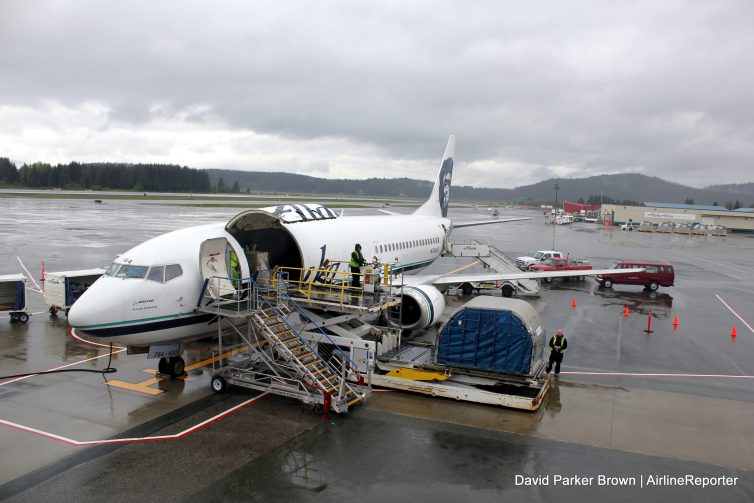
My Alaska 737-400 Combi in Juneau, AK
For the past six years, I have gotten up early and headed down to Alaska Cargo, at Seattle-Tacoma International Airport, to welcome the first Copper River Salmon of the season. It has always been one of my favorite yearly events, but I was hoping to do something different this year.
When I was invited to fly up to Cordova, Alaska to catch a ride with the first Copper River fish of the season, I said “yes!” When I was asked if I wanted to fly a “milk-run” to Cordova on the unique Boeing 737-400 Combi, I said “hell yes!” I had never flown on a Combi before and I wanted to get onboard before they retire from Alaska’s fleet.
My adventure would take me from Seattle (SEA) to Juneau (JNU) to Yakutat (YAK) and finally to Cordova (CDV). Bring it!
- Combi in the background
- Boarding from the rear
MILK RUN IN A 737-400 COMBI
The journey began by boarding an Alaska Airlines Combi at SEA and I found it odd that Alaska stuck to standard boarding procedures; pre-boards, VIPs, then rows 20 and higher. Thing is the plane only has rows 17-28. Whatever… with only 11 rows, it boarded quickly no matter how you did it (even weirder was in Juneau, where they boarded 17-22 first, then the rest).

The interior layout of the Alaska 737-400 Combi – Image: Alaska Airlines
Because it has cargo up front and passengers in back (there is some mullet joke here), you must board from the rear door. This means no gate boarding, but I always love being able to board on the ramp and get up close to the plane.
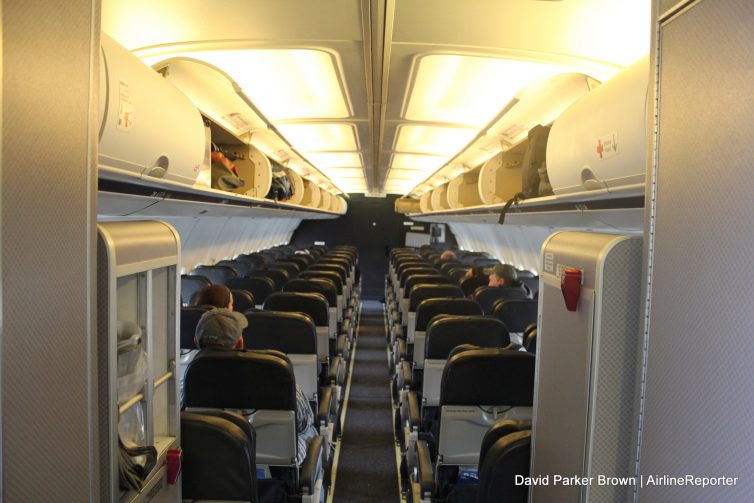
The inside of my 737-400 Combi
It was obvious that this bird had lived a long life. It looked like a dated 737-400 that was having minor improvements to run out its remaining (short) life. That sort of makes sense. Alaska will be retiring the Combi out of the fleet later this year. There will not be a direct replacement, but there are a few 737-700s that are in the process of being converted into cargo variants. So, if you have wanted to fly one of these aircraft — you’d better do it soon!
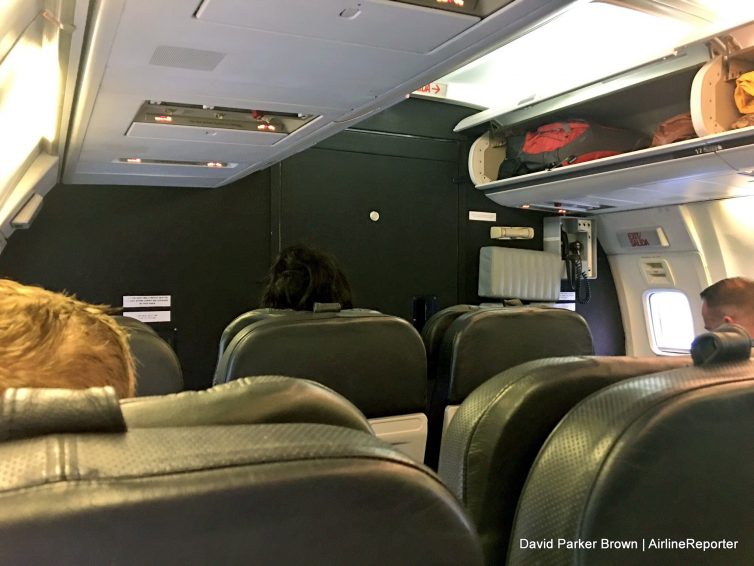
Why hello, wall!
Before the flight, I thought it would just feel like a shortened 737 and nothing that visually different. I was wrong.
It was very odd not seeing a forward galley and especially not seeing the flight deck. Instead there was a big black wall with an access door. I really have no comparison. The nose of a 747, you see the curvature and even a bulkhead row, you can see there is an aisle that keeps going. This is just BAM, end of cabin. It wasn’t a bad thing, just hard for my senses to process.
Taxi and takeoff was just like any other aircraft and soon we were on to Juneau. But first, I fell asleep — for about two hours of our two-hour-and-twenty-minute flight. Hey… I had to get up at 4:30am!
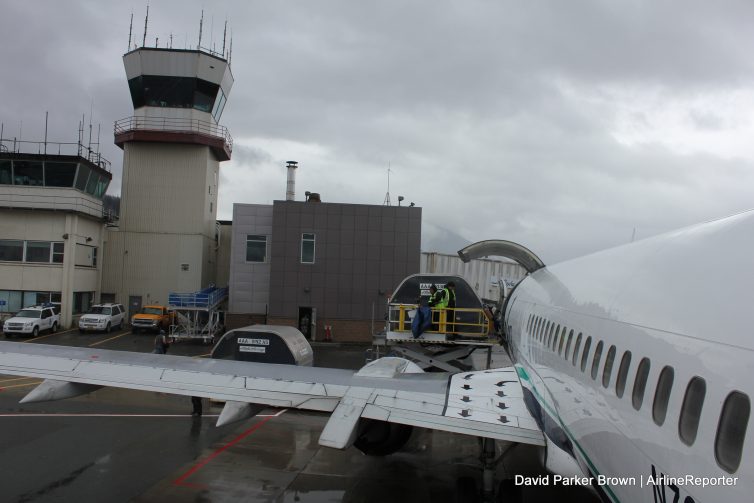
Cargo being unloaded in Juneau
A while back, when I did a tour of Alaska’s flight simulator, the trainer told me how difficult Juneau’s approach is. Then he showed me. Flight simulators are pretty realistic, but it is totally different when you are banking steep and fast, looking out and seeing trees level with your plane (on a mountain, when you are high up) and then — suddenly — you’re on the ground, and stopping as quickly as you can. I could tell most passengers flew that route often, because no one flinched.
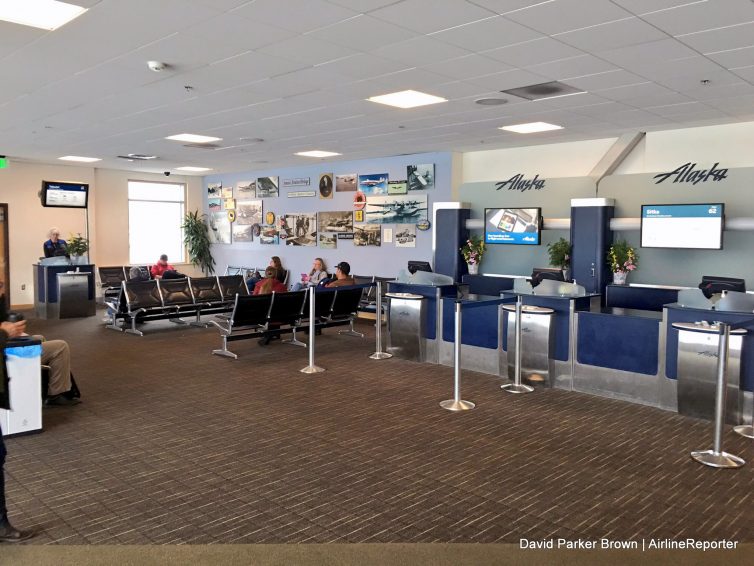
Part of the Juneau terminal with wall o’ Alaska Airlines history
We parked and most people got off. Those of us continuing on had the option of the staying on the plane or hanging out at the terminal for a while. I wanted photos, so I headed off the plane. As I walked in, I could see them starting to unload the cargo and prep for loading the new stuff.
I was quite impressed with the quality of the terminal. Most of it seemed new and spacious. It was comfortable for about the 30 minutes I was there before they started boarding again. Our flight out of Seattle there were no empty seats, but out of Juneau, it was about half full (or half empty, if that’s more your thing).
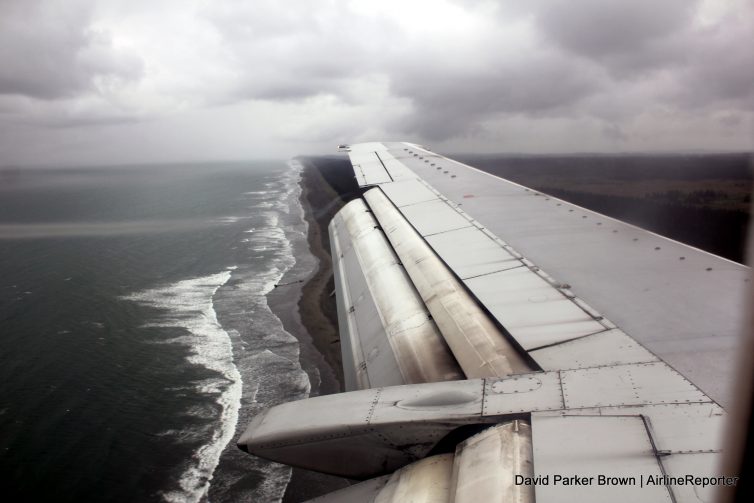
Coming into Yakutat
We quickly lined up on the runway and started to roll. Then GOOSE IT – full throttle, we quickly lifted off and ascended into the clouds. At that point, I wasn’t sure if the aggressive flying was because of the airport or maybe we had a cowboy flying.
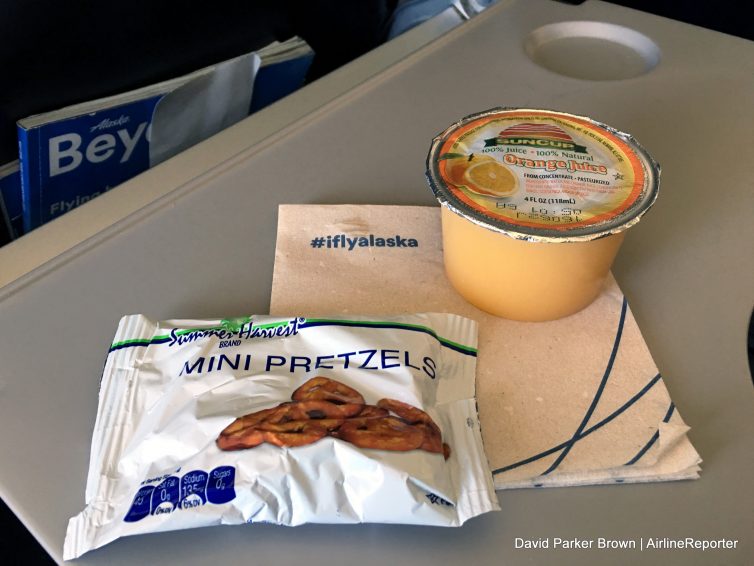
Not high-end, but some flavored liquid and salted starch.
The leg to Yakutat was about 35 minutes. For the short hop, they only offered water or orange juice. Oh yea… and some pretzels.
The aircraft actually has three flight crew, but I only saw two. The third is assigned up front, where there is a galley and lavatory by the flight deck. This is to make sure that there is never just one person in the flight deck at any given time.
As you can imagine, many flight crew love this aircraft. You have a small plane, which means more of an intimate relationship with the passengers. For my flight, the crew were very friendly, joked around, and got to know the passengers.
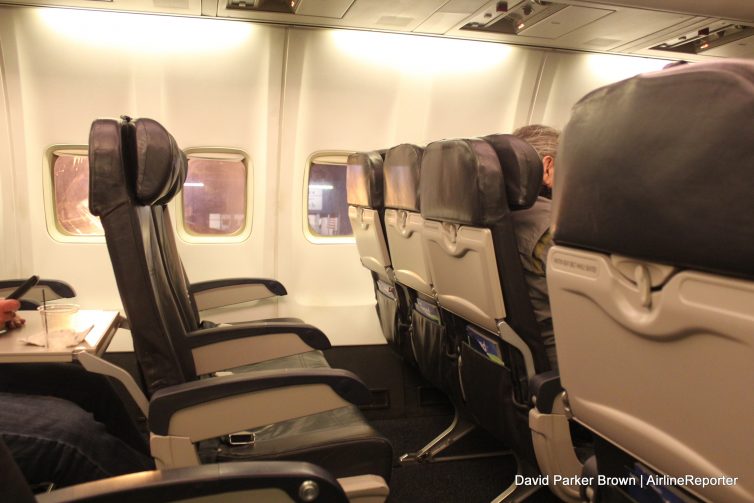
The cabin of my 737-400 Combi — dated, but it works
There was no in-flight entertainment; no screens, no plugs, no WiFi (wouldn’t work in Alaska anyhow). You have the window (which can be beautiful when not cloudy), you have the in-flight magazine, and you have staring at the seat-back in front of you. I used all three. It was not that big of a deal because it didn’t take long until we were at our next stop.
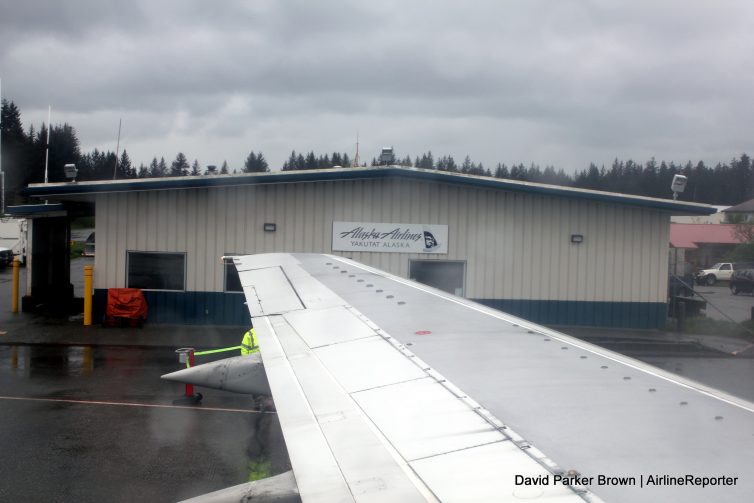
No getting out in Yakutat for me
Yakutat is… small. The population changes seasonally (due to fish season), but it can be about 650 people. When you land a full Combi, with 72 passengers and five crew, you are increasing the population by about 12%. Let that sink in.
We were told once again that those going on could stay on the plane or go to the terminal, but that there were no services, no amenities, no food, and no smoking (i.e. don’t get off the plane). Just like before, we left the airport fast and furious — I was getting used to it.
- Turning to taxi in Cordova
- The terminal
- See you later combi!
My last leg to Cordova (the flight was continuing to Anchorage) was also short — which meant reduced service. “Oh yes, I shall have the OJ on the rocks, with pretzels on a napkin please.”
We had another beautiful approach and I was holding on to my phone and camera tight this time — preparing for our landing. The captain did not disappoint.
There were only two of us who got off the plane and I headed outside to meet a big Alaska pick-up truck to take into Cordova to learn about fish.
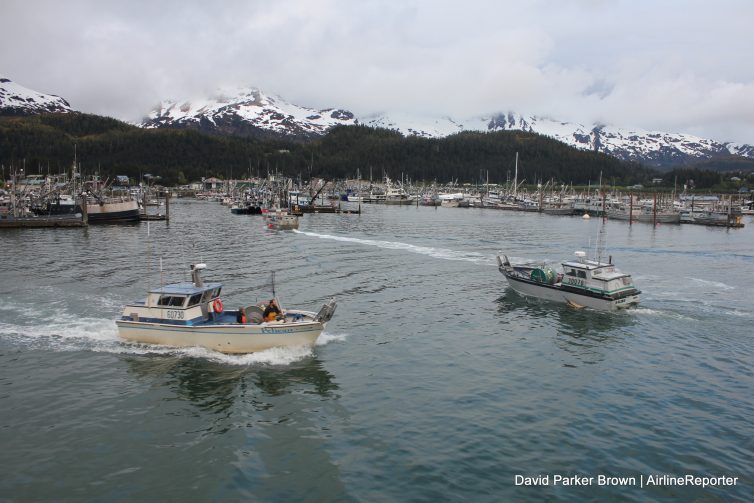
Fishing boats bring in Copper River salmon to Cordova, AK. That one boat almost has the old Alaska livery.
GETTING THAT PRIZE COPPER RIVER SALMON
I know we are not SalmonReporter here, so I won’t go into too much detail on this, but I can say the whole process is quite complex and interesting.
Turns out that there are about 550 licenses for boats to catch the Copper River salmon each year. I was picturing these huge boats (like on Deadliest Catch), but the boats were quite small and most are family run.
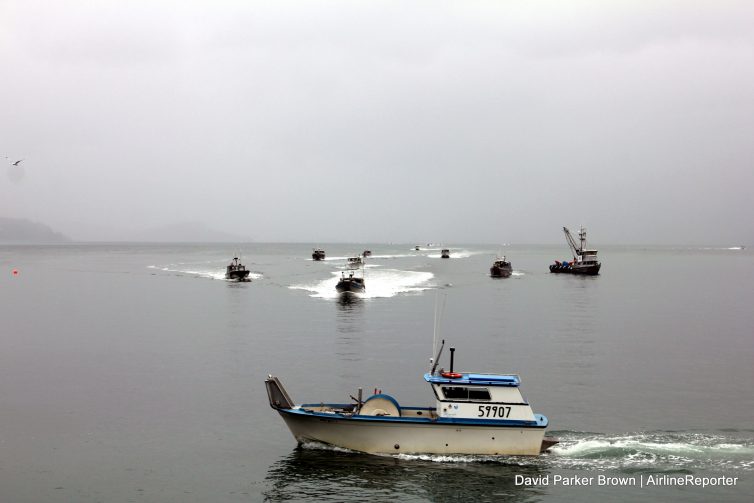
The boat on the right is the tender, the others are fishing boats coming back to port.
Biologists keep a close eye on the population and manage when the waters can be fished. Typically it is “open” for 12-36 hours, twice per week. The start of the season was 7:00am – 7:00pm on May 16th (when I was there).
When caught, most fishing boats meet up with tenders (bigger boats) and the fish is sold. Those tenders then bring them to processing facilities, like Copper River Seafoods.
- Outside of Copper River Seafoods
- Choosing the “winner”
After watching the hundreds of boats return to port, we headed over to Copper River Seafoods to check out their operation (I was not able to take photos of most things), and more importantly see which fish was chosen.
In one blue tub, there were some of the prize fish to be inspected and one was to be eaten in Seattle (is that a winner or loser then?). They looked at the size, the coloring, and if it was damaged (one had a seal bite). It didn’t take long for there to be a “winner” selected and he was pulled aside, put in a special cardboard box, and tagged to be the VIP for Seattle.
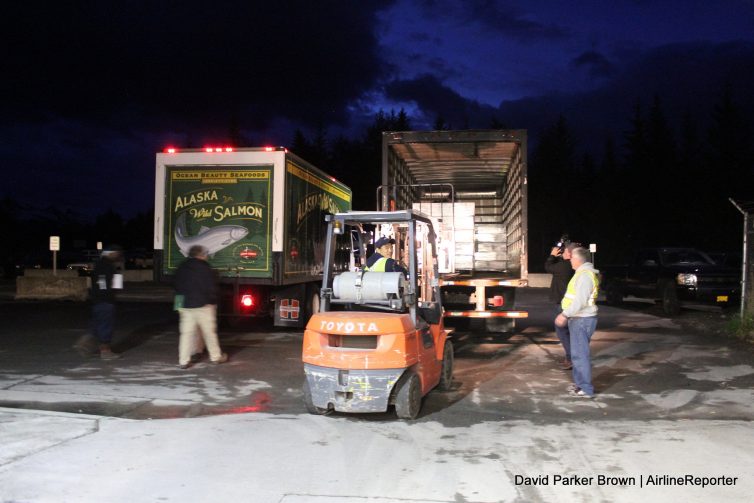
Unloading Salmon off the truck in Cordova
After our visit to Copper River Seafoods, we had a few hours before our flight. We decided to head over to the Alaska Cargo facility (attached to the small terminal at the airport) to await the fish being delivered. It didn’t take too long before trucks from different companies started dropping off pallets of fish. Each pallet was taken off the truck, via a forklift, weighed, prepped for transport, and then loaded up onto the plane.
Even though this was a special flight, with the only passengers from Alaska Airlines, two media, and representatives with Copper River Seafoods (about 15 of us total), we still had to check in, and go through TSA security. Since 2:00am is not a normal time for any flights to depart, I salute all those who showed up to process our group.
- Weighing the fish
- The chosen fish gets loaded on.
GETTING THE COPPER RIVER SALMON TO SEATTLE
I selected seat 19F and had an entire row to myself (like A-F). I got all settled and started to drift off to sleep. Then the captain came on and said there would be a delay due to weight balancing. 15 minutes later, he came on to say we would be furthered delayed. Overall, we ended up being about an hour late. Not that big of a deal for me, because it just meant more sleep, but there were lots of people waiting for us in Seattle and it could throw off the celebration.
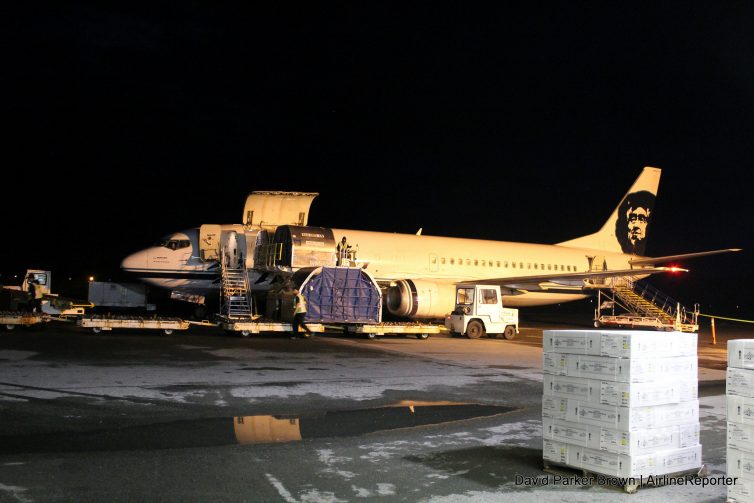
Our Combi awaits!
Soon enough it was time to leave. I was half asleep as the right engine started to power up. Even though I had my head on the wall and was not fully aware of my surroundings, I smiled, because that sound was so beautiful.
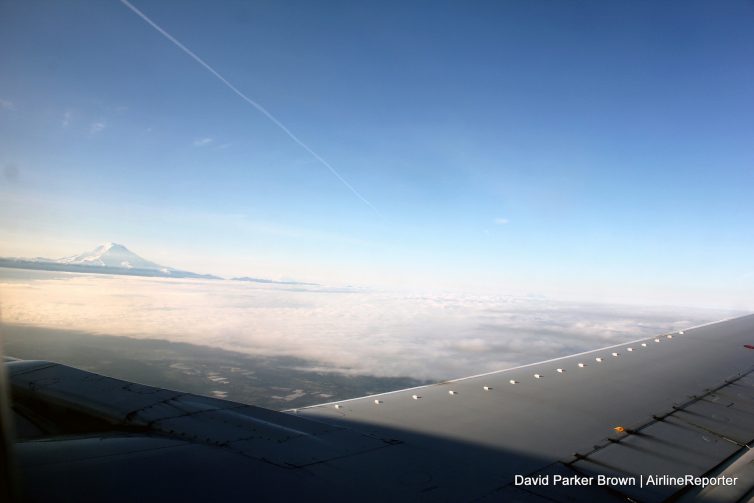
This view always means that I am almost home
We took off into the darkness. I left my sun shade open, since we took off at about 3:00 am and were landing at about 7:00am Seattle time. I forgot where we were. At about 3:45 am, the sky started to come alive and it was beautiful. I remember thinking it would make a great photo, and I should reach over to my camera sitting next to me. Instead I just closed my sunshade and went back to sleep.
Next thing I knew, we were almost there. I opened my shade and saw the beautiful Mt. Rainier outside… I was almost home.
- Cargo section on the Combi
- Watching my new friends get off the combi in Seattle
After landing, we all got up, gathered our things, and lined up to head out the rear door. I was moving kind of slow, so I ended up at the end of the line — bummer. But then I heard some sweet, sweet words. “We are deplaning from the front.” Not only was I now first in line, but this meant we were going through the center cargo area.
- Hello new livery
- People were waiting for us (Editor’s Note: I think they were waiting for the salmon)
- Time to prep the fish!
The large cargo door was wide-open, providing some nice views. After walking across, I had to push through a small door to the front galley and then down the stairs and we headed on over to the Copper Chef Cook-off.
%CODE1%
THE COPPER CHEF COOK-OFF AT SEA
Because we were on the plane, we didn’t see the fish being presented up-close. That’s okay; I had spent plenty of time with him already. By the time I saw him again, he was already filleted. He looked good, but in a very different way. Then it was time. There were some raw pieces for people to try. Sure, it was delicious, but the reality just hit me.
I got to be there when he was brought in by the fishing boats, saw Copper River Seafoods folks choose which was going to be flown to Seattle, hung out with him in the Alaska Cargo office for a while, watched him be carried onto the plane, flew with him down to Seattle, and now I was eating him. The power of the Combi!
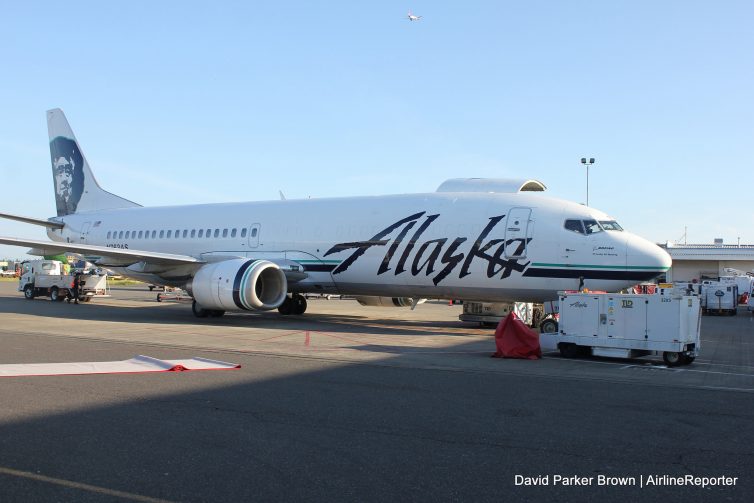
Thank you 737 — you were a good Combi to me!
Since it is unknown exactly what time he was caught, it was either 12 to 24 hours from the time he left the ocean to the time I was eating him at the airport in Seattle. Aircraft like the 737-400 Combi help make that sort of thing a reality.
There were 20,000lbs of Copper River Salmon on our flight, and Alaska Airlines will fly about 20 million pounds of seafood (in all forms) from Alaska this year. That’s a lot of seafood.
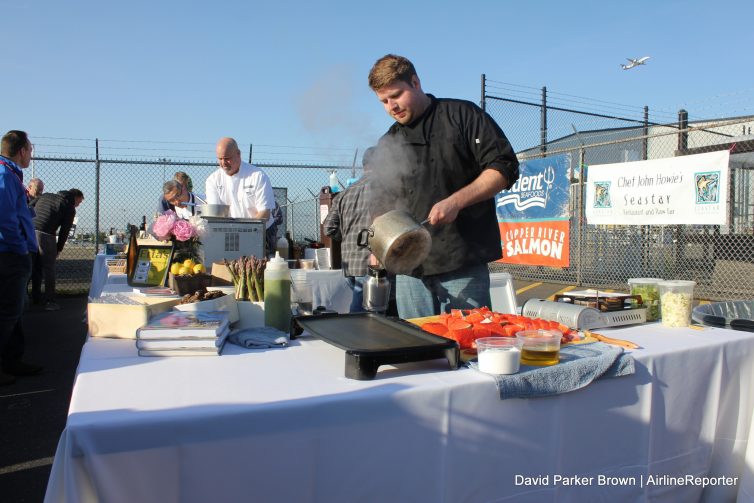
Cook off! At the airport. Why yes, I did time it so that sweet Q400 was flying over, thanks for noticing.
After I had my little moment with the fish, I turned my attention to the Copper Chef Cook-off. So, the basic run down of the competition: multiple local restaurant chefs cook up the salmon in different ways, and a few local celebrity chefs judge the winner.
The chefs were: Ethan Stowell, executive chef and owner of Tavolata, Anchovies & Olive; executive chef John Howie, owner of Seastar Restaurant and Raw Bar & John Howie Steakhouse; and Chef Sam Burkhart of Etta’s and Seatown Seabar Restaurant.
Then the judges were Seattle Seahawks wide receiver Jermaine Kearse; Lauren Bushnell, Alaska Airlines flight attendant and winner of ABC’s ’œThe Bachelor;’ Seattle Mariners Hall of Famer Jay Buhner; and Mike ’œTotality’ Kentrianakis, the astronomer and internet sensation who created a video in April of a total solar eclipse aboard an Alaska Airlines flight.
The entertaining emcees were Seattle culinary icon Tom Douglas and local media personality John Curley.
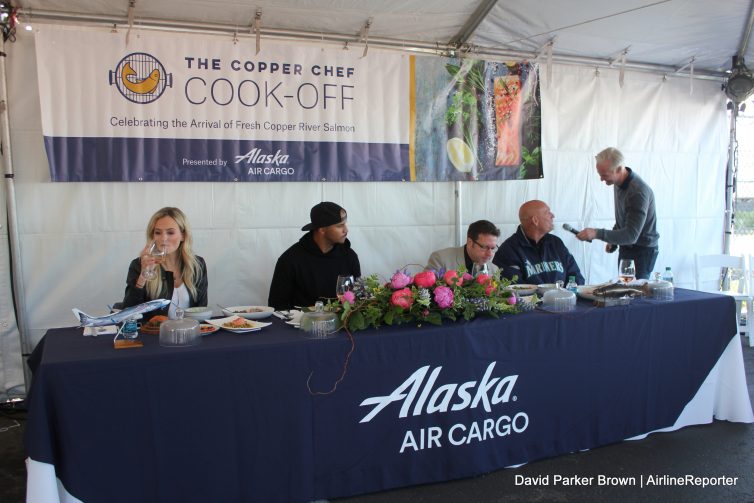
The judges do their darnedest to choose the best dish
This part is always a good time. Lots of fun little contests for the guests that were there, you can watch the chefs cook their food, and then I was able to try samples. After everything was said and done… Ethan Stowell was announced the winner (he won last year as well).
What a great (and delicious) journey.
See more photos of the Combi / Copper River Salmon adventure.
Note: Alaska Airlines provided transportation to and from Alaska, all opinions are my own.
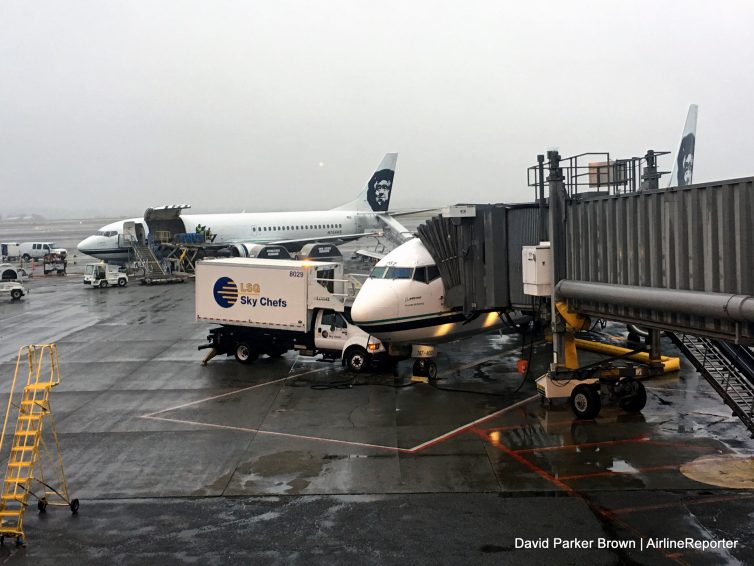
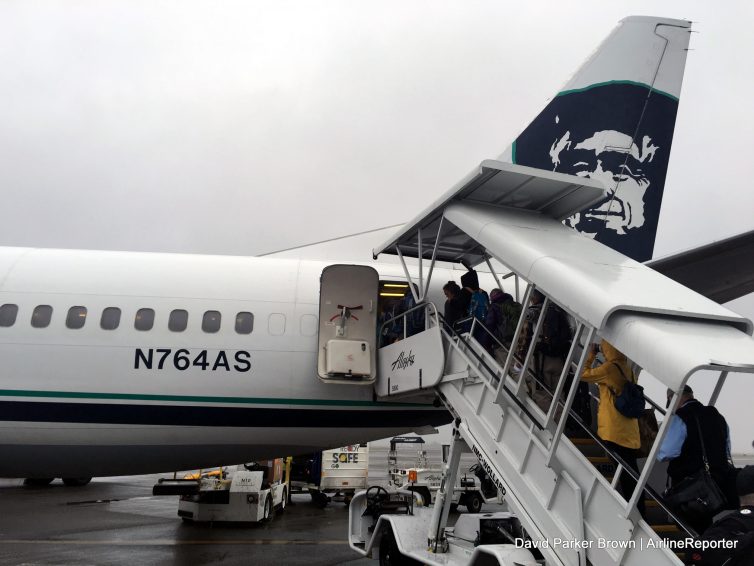
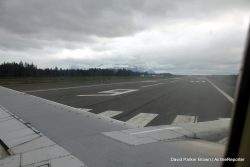
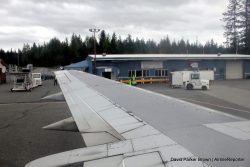
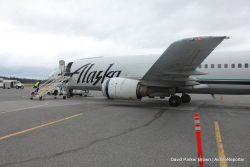
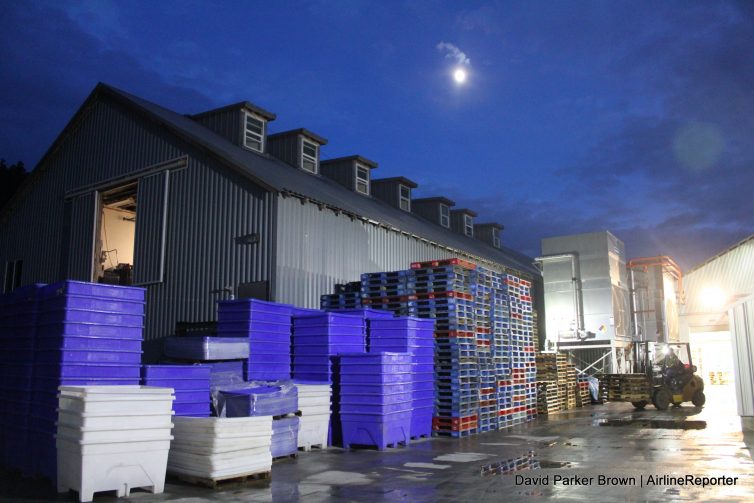
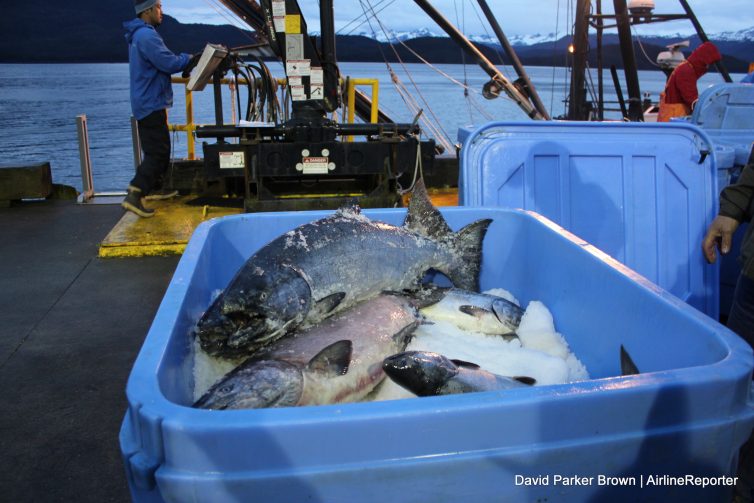
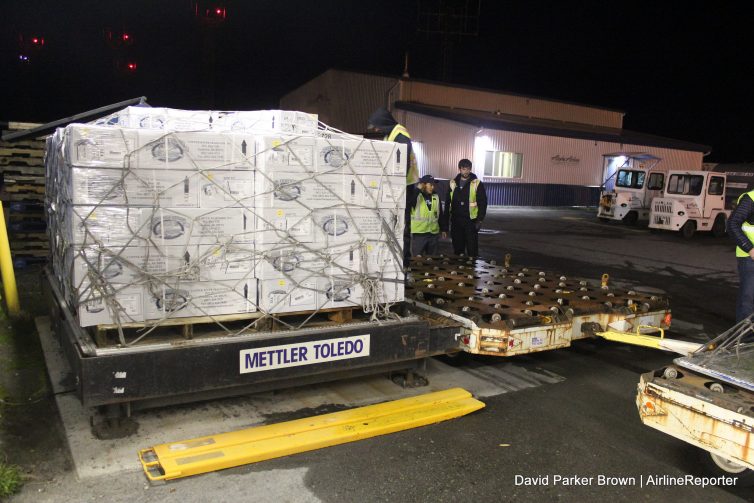
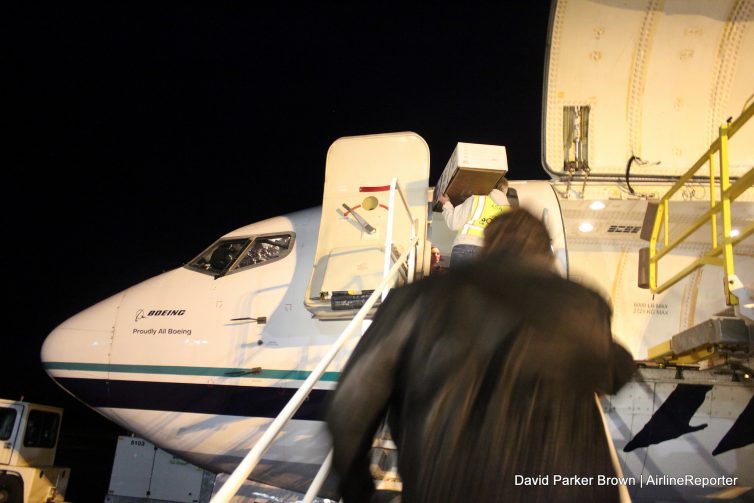
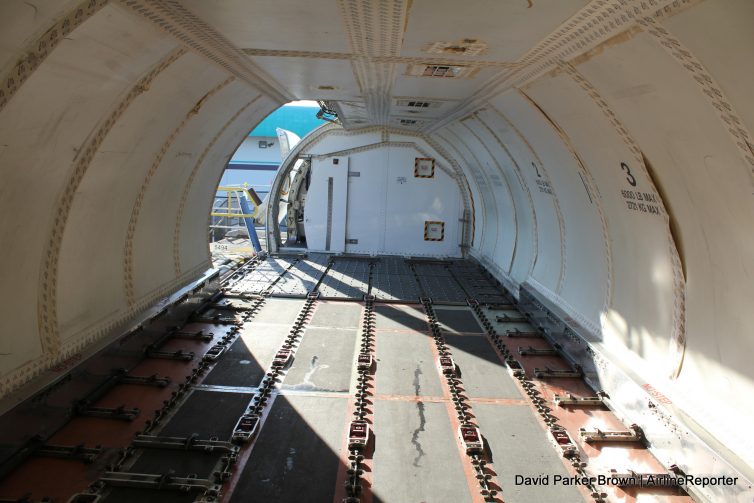
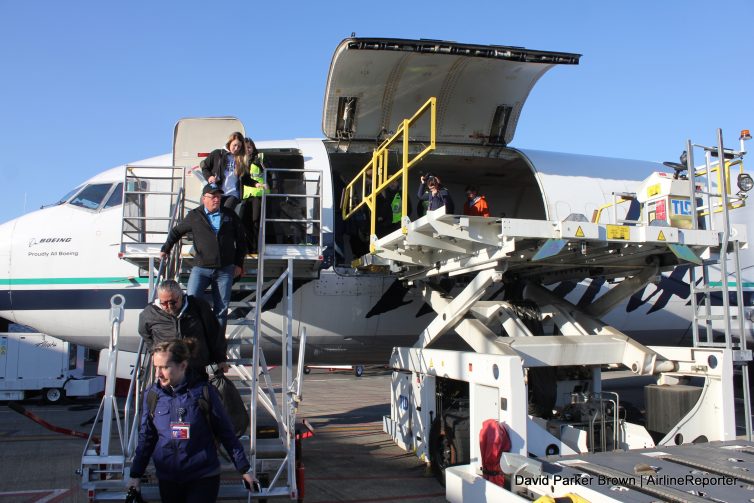
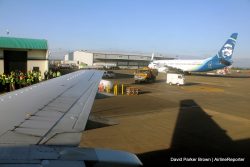
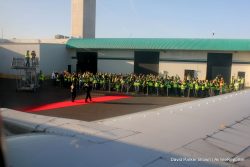
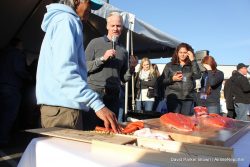
Great Article, David! You really know how to bring in the human touch to any avgeek material.
I was wondering, does the flight crew have access to the cabin (& pax) in case of any emergency mid-flight? The 747-combi has it’s cargo section at the back so I know it won’t have a problem……..
BTW I could totally relate when you said “I was half asleep as the right engine started to power up. Even though I had my head on the wall and was not fully aware of my surroundings, I smiled, because that sound was so beautiful.” I am reading this at night & that made me feel really sleepy (in a good way ;-P). So I switch on my A/C (which sounds like a 777 at cruising speed) and sleep as if I am snuggled up in private suite. Kind of like these pictures ————->
https://www.valueaddedtravel.com/assets/components/phpthumbof/cache/emirates-5.28dbeda294b19f310074ac95e53e5695.jpg
http://static.bizlive.vn/uploaded/nguyentham_pv/2015_10_15/emirates_xhdc.jpg?width=670
Hey Suraj,
There is emergency access to the upper cargo hold. Crew used to be able to easily walk through it, but then they upgraded to larger containers, and that is not possible. However, there are doors at the front and rear of the cargo area.
David | AirlineReporter
Thanks for clearing that up! So essentially the pilots are physically locked away from the cabin crew mid-flight unless they have an Ant-Man suit…..
They are pretty locked away from the passengers. There is one flight attendant who sits up front. There is still a galley and lavatory up there!
And of course once per year, there is a fish up there with them too :).
David | AirlineReporter
737-400’s often have CG issues a low operating weight. I can remember one flight on AS where the back half of the A/C was empty, and passengers were told they were not permitted to change seats. Presumably the Combi’s are operated on routes that generate substantial freight loads, and putting that load at the rear of the aircraft with a light passenger load would result in an unacceptable CG, so the freight section on the 737-400 combi is at the front of the aircraft.
Hey Matt,
Yea, all about weights. I have been on full passenger planes a few times, where they move everyone up front or back during take off for balance and then let people move around.
David | AirlineReporter
I flew a combi about 20 years ago from YOW to YUL. The plane had started somewhere up north (Iqaluit?) I don’t recall the plane (or the airline), but I remember that it only had 6 or 8 rows at the back. I sat at the bulkhead, and I was really glad that it was a short flight. My knees were jammed up tight against that wall. It was really strange to be staring at a blank wall during flight, especially from up close.
So is the cargo on that flight mostly salmon? There is a 747F that services YHZ that carries mostly lobster. I didn’t think that anything bigger than a 767 ever came to Halifax on a regular schedule, until I found out about this Korean Air Freighter.
Hey Mark,
The flight I was on, coming back to Seattle, I think it was almost all Salmon. But normally anything and everything is being hauled up, since that is the way that many small towns get their goods. And depending on the season, lots of seafood will be flown back south (Alaska Airlines will do about 20million pounds this year).
David | AirlineReporter
Fun piece, David. I think cargo on combis typically goes in back? Weird that this one is flipped. I’m sure for good reason, just weird. You’re a lucky man to have had the opportunity to do the trip in advance of the combi’s retirement.
If I may hazard a guess, the flipped layout is likely for use in those far-flung airports without jet bridges where the majority of the payload is cargo. Any 737 engineers wanna weigh in?
It’s due to two main reasons
1. 737s ideally operate with the nose heavier than the tail. If they loaded the heavier cargo in the rear and then lighter passengers in the front, then it wouldn’t balance (and could possibly tip. This is a problem with the newer 737-900s which do tip when baggage, cargo, and passengers are loaded in the improper order)
2. There isn’t enough clearance between the wing and the stabilizers to fit a cargo door where you can reliably load cargo without the risk of hitting the wing or stabilizer. With the cargo door in the front, everything in front of the engines is free space for cargo loading/unloading ops.
Hey JL,
I think partly because of weight distribution and I think also because of cargo door placement. Your 747s have room and structure for the door in the back.
David | AirlineReporter
What a fun, salmon season opener. Thanks, David, even if you did have to roll the bones out at 0430. A few may P. & M. about the antique -400 combi, complete with stream gauges and those full thrust take offs from short fields. Alaska is a unique market and the -400C is simply the right airplane in the right place; with no direct replacement in the pipeline, it will be missed. I’ve had the pleasure a few times, but not for the annual salmon opener. (I do wonder what will replace it…) And the best part of this annual feature story? As usual, everything is properly supervised by the IPA Hag in residence. Welcome to salmon season! -Cook
Hey Cook,
Any of the good airline stuff requires me to get up before 5:00am — it is all worth it :). Actually, Alaska is in process of converting some 737-700s (in Tehran of all places) to be 737-700Cs. They will replace the 737-400Fs, but the Combis are going away :(.
David | AirlineReporter
David, Aren’t the 737-700s being converted in Israel? Tehran in Iran seems like a weird place since they just recently got the ability to get new US airplanes
Hey Nick,
They are being done in Tehran… it was all about bidding and how cheap it could be properly done.
David | AirlineReporter
David-
Fascinating article! Was not familiar with this aircraft, so great to see the words and photos of your experience. Must’ve been pretty unusual taxiing in that (relatively) large 737 up to such small terminals.
To Nick’s point, I think Israeli Aerospace Industries, Who is doing the freighter conversions for Alaska, would be pretty surprised to learn that they are located in Tehran! Given the politics, Iran probably would not be too pleased with that fact either.
Thanks Dave, great story and you got it live!
Another solid article David. Sounded like a hell of a good time despite the early wheels-up.
One of these Combis should definitely go to a museum when AS is done with them. The others? I’m sure enterprising businesspeople can think of more creative uses….
Come on Boeing, you can make a -800 or -8 MAX combi. You know you want to….
Hey Phoenix,
There actually is a replacement, but not many have ordered them (The US government and Air Algerie): https://www.airlinereporter.com/2014/07/the-unique-boeing-737-700c-gets-some-love/
David | AirlineReporter
Thank you Alaska Airlines and all the fishers who brought the Copper River salmon to my dinner table tonight! The best salmon ever!
And thanks, David, for sharing your story…..
You are welcome mom 🙂
David | Son
Hi . I flew on 737 Combi Air Lingus 200 series I think ? In January 1977 Landed at Liverpool in a snow storm ! Now based in Cornwall UK.
Why suggest that the Wifi (Gogo) wouldn’t work in Alaska? There are towers all up the coast and in to the center of the state supporting the service.
Yup! That’s what I get for not following this stuff very closely. Looks like Gogo does have coverage to most of the places I would have gone (I am guessing around Yakutat would not have worked). Thanks for pointing it out — fixed the story.
David | AirlineReporter
Great article David, and very good and enjoyable picture, a really interesting insight to Alaska Air activities, more so as I have a very good friend, Senior Captain, still flying with Alaska Airlines, thank very much for allowing me to fly with you, courtesy of this fine article.
Roy Fordham, ex-RAF UK, now living in Cairns (CNS for the aviation minded), Queensland, Australia.
My wife and I did JNU-YAK-CDV-ANC in a Combi in ’08. It is definitely a different side of Alaska… watching Costco and Home Depot boxes get loaded and unloaded. We had an almost empty plane, too. I think I took some of the same pictures. 🙂
I felt likeI was there but missed out on getting a bite
I am a CSA in Yakutat and we will miss the combos! I understand why they are going away, but it will truly be a loss for the people of Yakutat. We depend on the combis for so much….. Not just getting seafood to the fresh markets across the country, but for fresh produce and dairy products, boat motors, car and truck parts so we can keep moving. I hope the plans for cargo service without the combi can actually give us the same good freight service we depend on. The only way in and out of Yakutat is by air or by sea. The milk run flights keep us connected with the people, places, and things that we need. Alaska Airlines keeps this community alive.
Hey Gayla,
I am sure you will end up with full cargo, and with the new (to the airline) 737-700Cs coming, it will hold more than the 737-400Cs.
David | AirlineReporter
Great story….love hearing stories like this….what is the best window seat to have on the combi…..I would also like to one day to the Air Mike hope from HNL to GUM…..have never been on a combi and would love to see what it’s like….thanks Bobby
Hey Bobby,
Not sure if there is really a good seat. I liked being a bit more near the front, to see in front of the engine!
David | AirlineReporter
Have flown on the combi many times, starting as a kid for school activities. Such is the life of SE AK high schoolers, we have mileage plan cards before we can read! I always think of the milk run as the weekday flight from Seattle to Anchorage, stopping in Ketchikan (my hometown), Wrangell, Petersburg, Sitka, and Juneau. Makes for a really long day. I think Sitka has the freakiest landing, though my roughest was definitely into Juneau a few years ago.
Liked your report!
Thanks Jen for sharing your experiences. I got a bit of perspective when one of our writers was telling me about when he white water raft for 12 days in the Alaskan wilderness and Yakutat was the “big city” he saw on his way home. It is a different world up north and so many awesome things, but I think a bit isolated for me.
David | AirlineReporter
You “flinched” when flying into Juneau, try K-town (Ketchikan) some time. This is standard stuff for Alaskans going to/from home.
I am looking to do this trip with my family. Taking in all 50 state capitols. Looking to do a stopover on way to ANC, maybe on the way back do same in Sitka. Can you see Glacier Bay National Park or what kind of view would you have if we tried this as a family to see alot and then get toe ANC go to Denali, Seward, etc? Thanks.
Would be overjoyed if I were to be able to take this flight, if I could have Senior Captain Instructor Keith Arrol in Command.
Keith, a dear friend of many years, has been, and still is a true gentleman, and has an enviable, safety aviation career record, in both Military and Civil aviation to be very proud of.
I myself, have had many years of involvement in aviation, however, my experiences pale to what Keith has known, but one thing I am happy to say, is that I was able to introduce him to my most favourite airplane, the de-Havilland ‘Tiger Moth’ here in CNS, Qld, Australia.
Both the ”dear old Tiger and I have something in common, this being our ages, as the ‘Tiger’ ‘first spread our wings’ in 1931.
I was born September 15th 1931, (this now celebrated as the official Battle of Britain day) and the ‘Tiger’ first flew October 26th 1931.
So I guess, now at 85 years young, we have both experienced many of lifes changes, but happy to still both be around.
I this hasn’t been a bore for anyone, but it sure is nice to have a lot of memories some sad of course, but many happy ones.